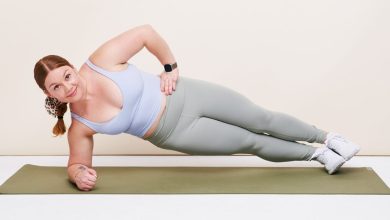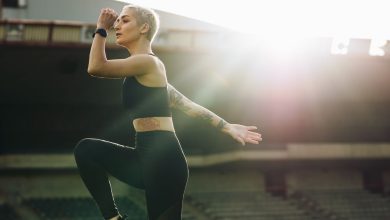16 Plyometric Exercises That’ll Build Explosive Strength
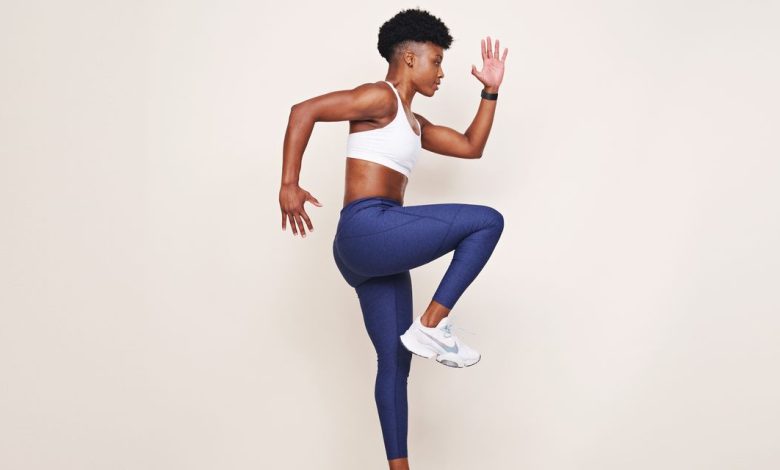
From box jumps to lateral bounds to burpees, plyometric exercises can be…intimidating. It makes sense then if you think they’re only for a certain type of exerciser–for example, the ex-college athlete, or the 20-something CrossFitter.
The truth though? Plyometrics (or plyos for short) are great for almost anyone. They can be scaled to tons of different ability levels, from beginner gym-goer to pro athlete. And they provide a host of real world benefits that help you move about life more efficiently, effectively, and safely. That makes plyos a smart addition to your–yes, your!–routine.
Also called “jump training” or “explosive training,” plyometrics are movements that involve rapid stretching and contracting of your muscles, Kat Paslé-Green, CPT, a certified personal trainer and coach at Bay Club in the San Francisco area, tells SELF. “Anything that involves catching a little bit of air” can be considered a plyometric, Paslé-Green says. That means exercises centered on jumping, leaping, bounding, and hopping all fit the bill. A pop squat, for example, is a ploymetric–as is a jump lunge, hands-release push-up, and single-leg hop. Typically, plyo moves are bodyweight only since lifting heavy will compromise your ability to execute them quickly.
Karlie Booker, CPT, a certified personal trainer at Pro Club in Redmond, Washington, is a big fan of plyometrics. “I make all my clients do plyos,” Booker tells SELF.
Below, we dig into all the awesomeness plyos have to offer, important safety caveats to keep in mind, how to weave them into your routine, and 16 stellar examples you can try at home today. Let’s hop to it!
What kind of exercise are plyometric moves?
Plyometrics are mainly a power exercise since they’re all about performing explosive movements at max effort (or close to max effort). Plyos are also good for challenging your strength since your muscles have to work hard to perform them correctly. They tap into your anaerobic system, which fuels your body during exercise that’s so intense you can’t keep it up for more than a couple minutes at a time, as SELF previously reported. That’s what makes them so tough.
Now, people may wonder if plyometrics are an isometric exercise technique. The answer? Nope. That’s because plyometrics involve quick movements and concentric (shortening) and eccentric (lengthening) muscle contractions. An isometric exercise, by contrast, involves muscles staying super still while they work. A plank, for example, is an isometric exercise.
In terms of which muscle groups plyos work, for the most part they are actually full-body movements, NASM-certified personal trainer Keith Hodges, CPT, founder of Mind in Muscle Coaching in Los Angeles, tells SELF. That said, many plyometric exercises—like jumping lunges, pop squats, and tuck jumps—place an extra emphasis on your core and lower half. But there are some upper-body-focused plyo moves too, says Hodges—for instance, plyo push-ups and explosive medicine-ball throws.
Keep in mind: Part of what makes a plyo a plyo is how intensely you perform it. By definition, plyometrics are explosive movements performed at max effort, so you should only be able to do a handful of reps at a time before you’re gassed. So if, for example, you bust out 30 jump squats in a row, that’s likely going to be more of a conditioning exercise than it is a true plyometric, Booker says.
What are the benefits of plyometric exercises?
There are many benefits of plyometric exercises that might just convince you to add them to your workout routine. They can help increase speed, strength, endurance, agility, and coordination, says Hodges. Plyos can also boost tendon strength and increase your rate of force development—essentially, your body’s ability to generate a lot of power really fast, says Hodges. This can come in handy for athletes whose sports require them to perform quick, powerful movements—like track athletes, for instance, or volleyball players.
Plyometric training can also help reduce your risk of injury both in sports and at the gym, since they improve your body’s ability to quickly absorb shock. “Most injuries occur when the body goes beyond its range of motion with control,” explains Hodges. For example, if you jump up to block the ball in a game of beach volleyball and don’t land back on the ground with good mechanics, you could tear a muscle, tendon, or ligament. With proper plyometric training you can boost your ability to effectively and safely absorb shock and thus reduce the risk of injury in sports and workout settings. In fact, plyometrics are “top tier” when it comes to injury prevention, Booker says.
Beyond exercise-specific scenarios, plyos have tons of carryover into your day-to-day, Paslé-Green says. Plyometrics “simply train your muscles to generate power quickly,” she explains. And this can come in handy whether you’re chasing after your dog, hoofing it up the stairs to make a meeting, or reacting promptly to prevent a fall after you catch your toe on the curb.
Then there’s the longevity benefit: When performed correctly, the controlled force impact of plyos can stimulate bone remodeling and improve tendon and ligament strength, Paslé-Green says. This helps build new bone tissue and retain muscle–two components that “greatly benefit healthy aging,” Paslé-Green says. To boot, plyos help retain your power. That’s important because your power naturally and rapidly decreases as you age, Booker says. So by training it, you can prevent some of that decline and ensure you have that quick explosiveness when you need it.
Are plyometric exercises safe?
The big benefits of plyos come with a big caveat: There is a higher risk of injury with these moves than more traditional strength training or cardio since they are a high-impact form of exercise performed at max effort. That’s why it’s really important to nail the basic form of a movement (say, lunges) before you add a plyometric element to it (like jump lunges). It also means that you should likely hold off on plyometric exercises for beginners until you have some experience with working out—people just getting started with fitness should become comfortable with the traditional forms of the moves first.
When first dabbling with plyos, focus on having as minimal contact time with the ground as possible, Booker says. Think of it as “a hot lava situation, like you barely kiss the ground and immediately rebound to the next jump,” she says. Then, as you get more comfortable with the movement and master good form, shift your focus to achieving as much height or distance per rep, she says. Remember: All plyos are scalable–by changing the height, distance, or intensity at which you perform a move, you can likely match it to your current level. Take a box jump, for example: Instead of starting with a 12-inch box, you can literally begin with a one-inch platform.
With plyometrics, the execution of a move isn’t the only part you need to master. The end part of the move, or the landing, is also very important.
“When I’m doing plyometric training, I always start with landing mechanics,” says Hodges. “So before teaching anyone how to jump, I want to show them how to land correctly.” This means returning to the ground with proper form and effectively absorbing shock. The correct positioning depends on what movement you’re doing, but as an example, if you’re doing a jump squat, it would include landing quietly (instead of letting your feet smack the ground) with your legs shoulder-width apart, slightly bent knees that don’t collapse inward, an engaged core, and a sturdy upper body (so no swaying back and forth). Beyond landing mechanics, it’s also super important to make sure you feel really solid about your ability to do the entire movement correctly before you amp it up with a plyometric element. Not sure what good form means or whether you’re doing a move right? Get help from a qualified fitness pro.
Another important safety tip: Make sure you’re properly warmed up before you do any type of plyo work, since jumping into it (pun intended) cold can increase your risk of injury. Then, once you do get into plyo exercises, be sure to listen carefully to your body. If you notice your form is starting to falter, either tone down the intensity of the move so that you can resume good form (for example, lower the height of your box jumps), or just call it quits on plyometric exercises for the day (for instance, go back to regular lunges instead of jump lunges).
How can you use plyometrics in your workout routine?
Feeling excited about the benefits of plyos and ready to try a plyometric workout? That’s awesome! But there are a few things you should know first.
First off, plyos are “not something you want to do every day,” says Hodges. The “right” amount of time per week to incorporate plyo work really depends on your goals and fitness level. But in general, plyo beginners should start with one to two days a week of plyo work and gradually ramp up the intensity from there, Hodges advises. Make sure that you pencil in enough rest time in between plyo sessions so that your body has enough time to recover. If you feel too sore from yesterday’s workout to do today’s plyo set with proper form, listen to your body and scale back your plans. Attempting plyo work when your body’s not at its best can set the stage for injury.
When you feel ready to sprinkle in plyometric exercises, start with a low rep count, and pick just an exercise or two. Hodges recommends between three or five reps per exercise as a general starting place. “You want those reps lower because you’re going to be very fatigued,” he explains. Also make sure that you give your body enough time to rest in between reps and sets so that you can maintain good form and truly give every plyo move your all or close to max effort. The right amount of rest will vary based on your fitness level, goals, and the intensity of the specific move, so just be sure to stay mindful of how your body feels and tailor your rest periods accordingly.
In terms of when in a workout to do plyos, Booker suggests tackling them first thing after a good warm-up. That’s because they are super intense–on both muscles and your nervous system–and demand a high level of skill, so you want to do them when you’re freshest to ensure quality form.
Plyometric Exercises
Here are some plyo moves that you can try at home with just your bodyweight.
1. Double Leg Pogo Hops
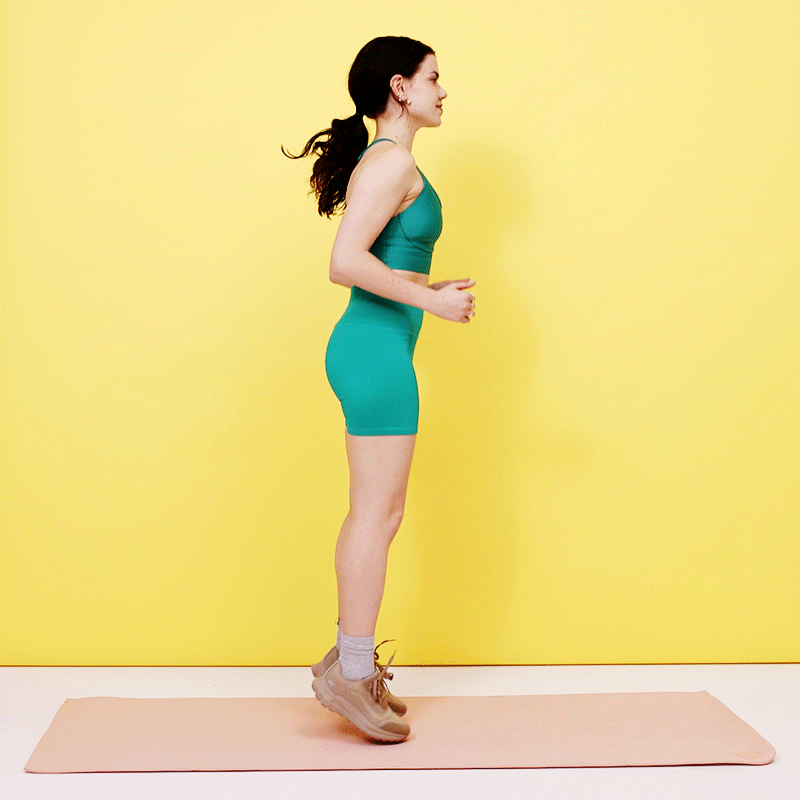
Katie Thompson
- Stand with your feet close together, elbows at your sides and thumbs pointing at the ceiling.
- Jump straight up, focusing on getting as high off the ground as you can.
- Land on the balls of your feet, then jump up again as quickly as possible. (Picture a pogo stick.) This is 1 rep.
This is a light plyometric that’s appropriate for people new to this form of exercise, as well as those just returning to impact activities (think: folks who are postpartum or recently recovered from injury). The idea here is to pretend the floor is hot lava, Booker says, meaning you minimize the time your feet are in contact with the ground. You can also hop forward and backwards over a line (real or imaginary) on the ground floor. Once you’ve mastered this, make it more intense by hopping on just one foot at a time.
2. Lateral Double Leg Pogo Hops
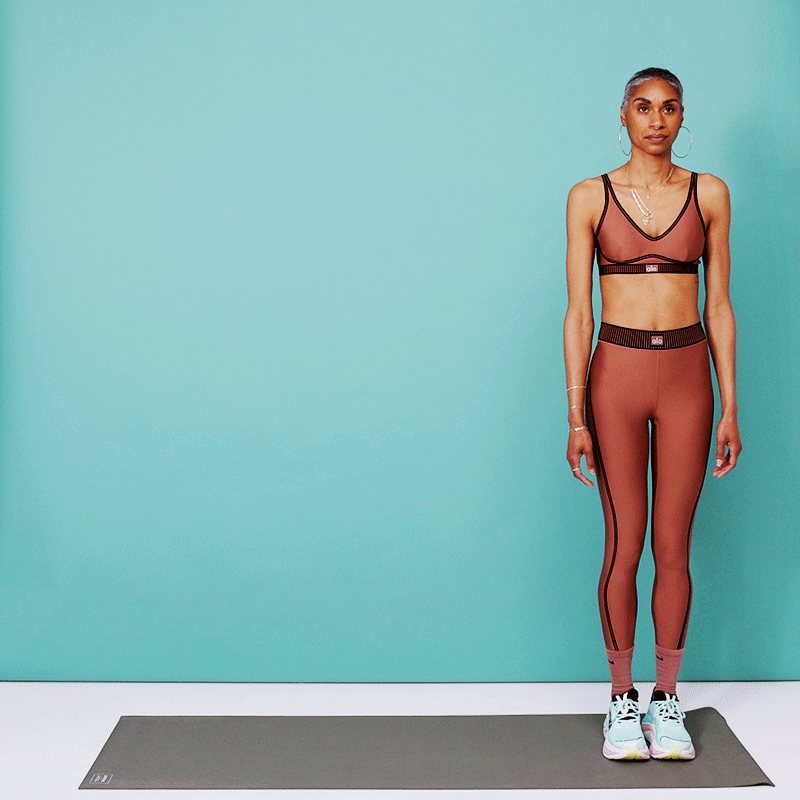
Katie Thompson
- Stand with your feet close together, hands on your hips or at your sides.
- Jump straight up and to the left, focusing on getting both high off the ground and traveling sideways. Land on the balls of your feet, then jump up and to the left again as quickly as possible. (Picture a pogo stick.)
- Complete a set number of reps to one side, then repeat on the other side.
This is a variation on the above exercise that has you hopping sideways instead of staying in place. If you’re limited on space, you can hop side-to-side over a line (real or imaginary) on the floor. Again, make it more challenging by doing single-leg hops.
3. Pop Squat
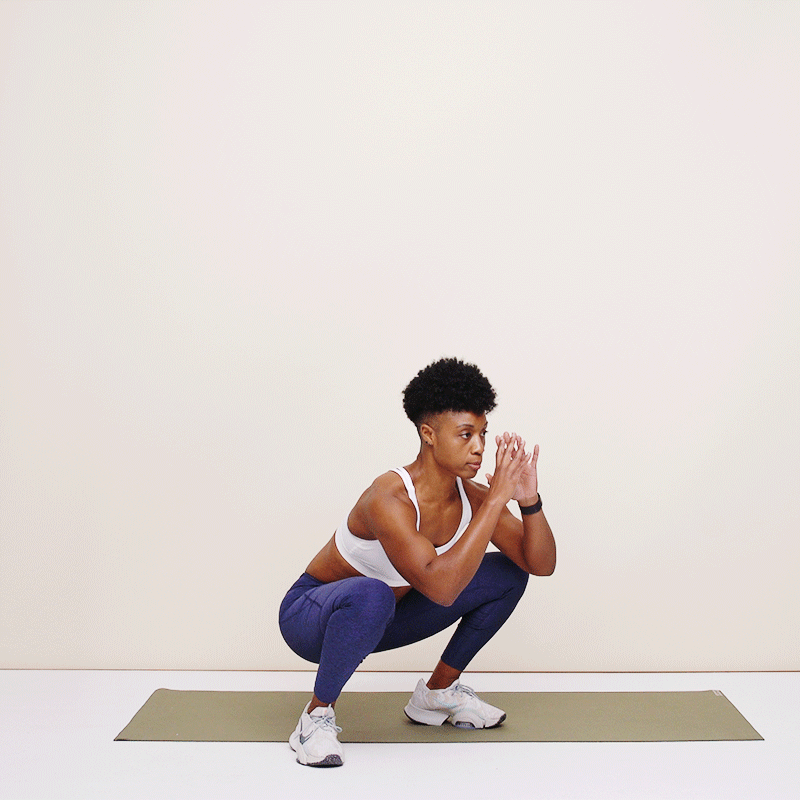
Katie Thompson
- Start with your feet wider than hip-width and do a squat by sending your hips back, bending both knees, and bringing your palms together in front of your chest. Keep your core engaged and push through your glutes to stand.
- As you stand, let your arms fall by your sides and jump to bring both feet together, taking a hop in place.
- Immediately jump the feet apart and sink into a squat again. That’s 1 rep. Continue performing reps, hopping once in place between each squat.
This move is a plyometric variation of the squat, a classic lower-body exercise that targets your quads, glutes, and core.
4. Split Squat Jump
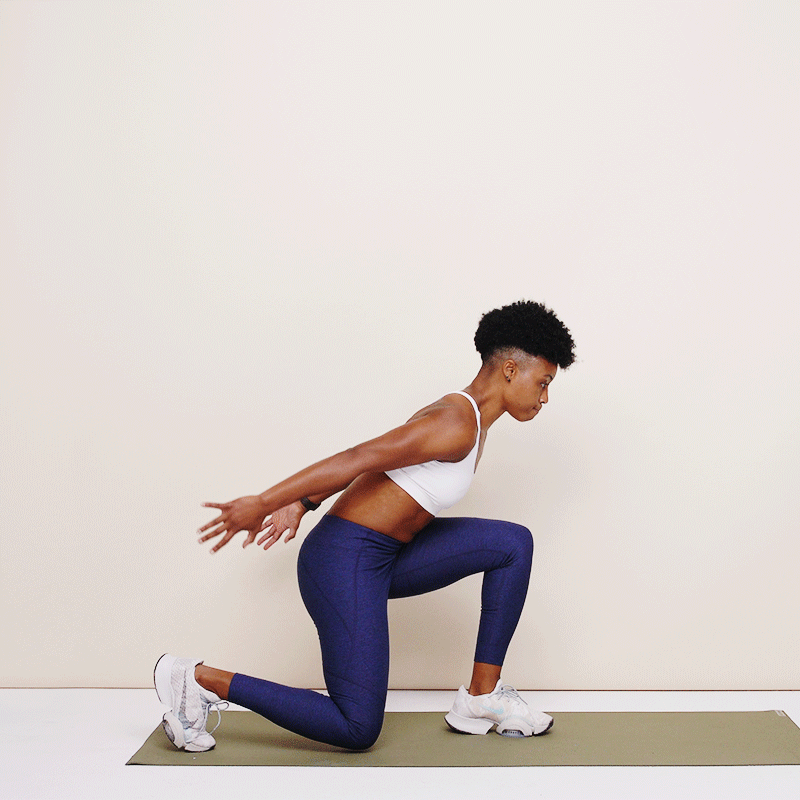
Katie Thompson
- With your feet underneath your shoulders and hands at your sides, step your left foot forward as if you were doing a forward lunge; keep your left heel firmly planted.
- Bend both knees to create 90-degree angles with your legs. Your chest should be upright and your torso should be slightly forward so that your back is flat and not arched or rounded forward. Your left quad should be parallel to the floor and your left knee should be above your right foot. Your butt and core should be engaged. This is the split squat position.
- Push through your left foot to jump as high in the air as possible, bringing your arms together in front of your chest. Land softly and immediately sink back into the split squat position. That’s 1 rep.
- Complete all your reps on one side. Then switch sides and repeat.
This exercise is a plyometric variation of the split squat, another classic lower-body move that works your legs and glutes.
5. Alternating Lunge Jump
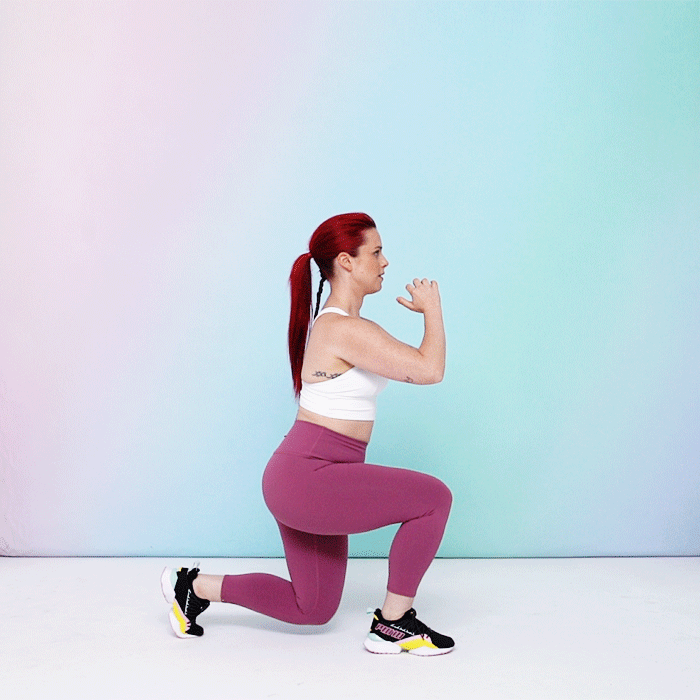
Katie Thompson
- Stand with your feet shoulder-width apart.
- With your core engaged, jump your left foot forward and your right foot back, and bend both knees so you drop into a lunge.
- Hop both feet back to starting position.
- Now hop your right foot forward, and left foot back, and drop into a lunge on the other side. That’s 1 rep.
This move is similar to the split squat jump, but alternating feet makes it a little tougher—plus it brings a coordination challenge too.
6. Reverse Lunge to Knee-Up Jump
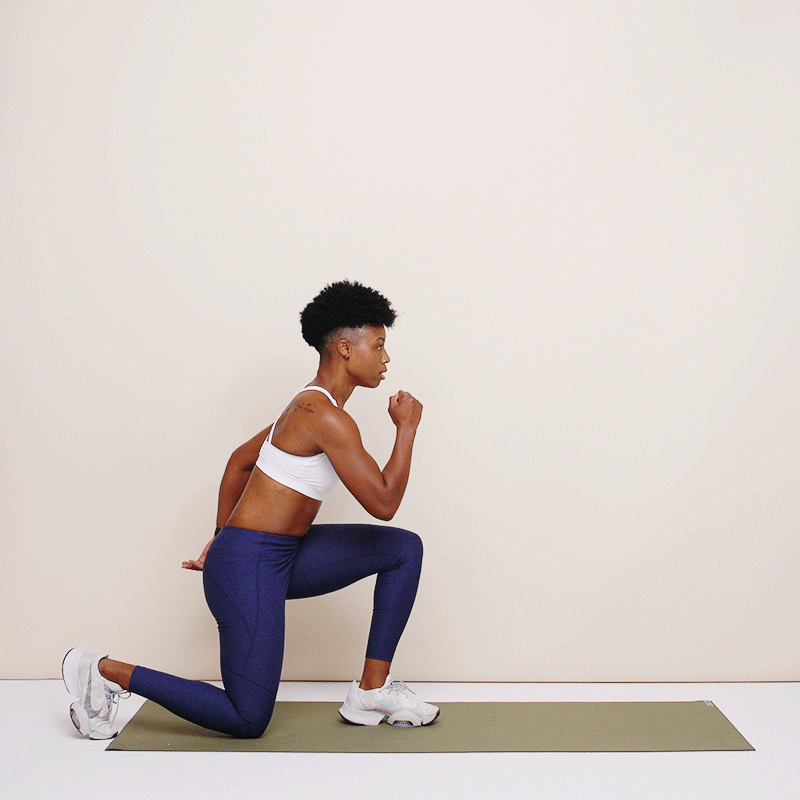
Katie Thompson
- Stand with your feet about shoulder-width apart and engage your core.
- Step backward with your right foot, landing on the ball of your right foot and keeping your right heel off the ground.
- Bend both knees to 90 degrees as you sink into a lunge. Swing your right arm forward, elbow bent, and your left arm slightly back, elbow bent. Focus on keeping your core engaged and your hips tucked (don’t stick your butt out).
- Push through your left foot to jump up as high as possible, driving your right knee toward your chest.
- Land softly on your left foot and then immediately sink back into another lunge. That’s 1 rep.
- Complete all your reps on one side. Then switch sides and repeat.
This move is a plyometric version of the reverse lunge. The reverse lunge works the major muscle groups in your lower half, including your quads, glutes, and calves—and the jump at the end adds explosiveness.
7. Tuck Jump
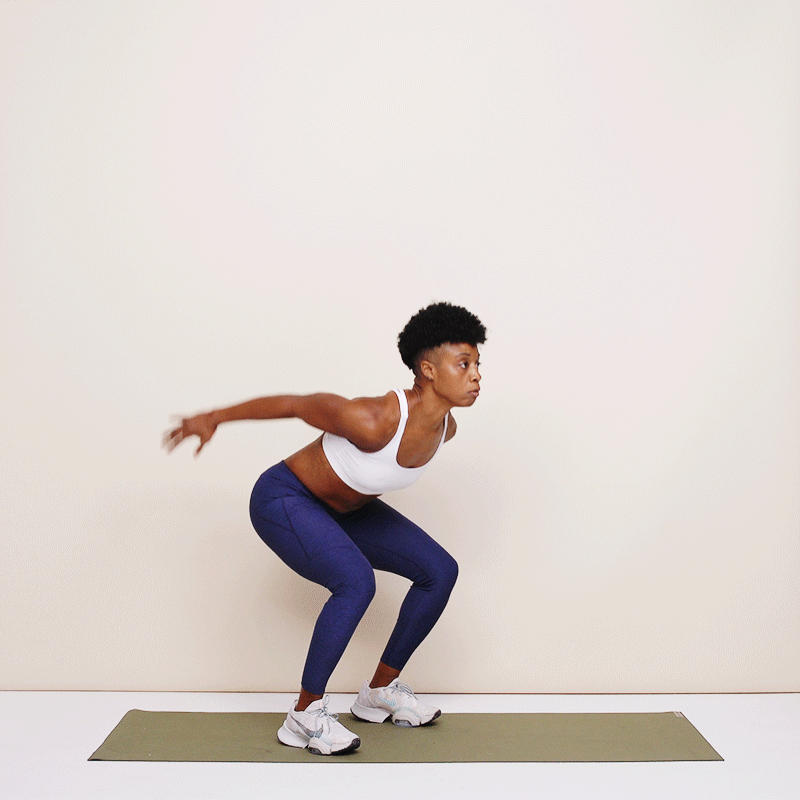
Katie Thompson
- Stand with your feet about hip-width apart. With your arms at your sides close to your body, bend your elbows so that your forearms are pointed straight out.
- Bend your knees and push your butt back into a squat, shifting your weight back as you do so. Don’t let your hips sink below your knees.
- Jump as high as you can. As you jump, engage your abs and drive the top of your knees toward your forearms. Keep your back upright; try not to lean forward.
- Land with your feet hip-width apart, with soft knees, and then immediately sink back down into the squat.
This advanced plyo move engages your entire core and back, especially the lower part of your abs, celebrity trainer Simone De La Rue previously told SELF. Make sure your knees don’t cave in when you squat or jump, says Hodges.
8. Skater Hop

Katie Thompson
- Stand with your feet hip-width apart. Lift your right leg and jump to the right. Let your left leg straighten and follow.
- As you land on your right foot, swing your left foot behind you but keep it off the floor. Swing your left hand in front of your body as your right arm swings behind your back.
- Swing your left leg back to the left and jump, landing lightly on your left foot and allowing your right foot to swing behind you. Swing your right arm in front of your body as your left arm swings behind.
- Continue, alternating sides.
This is a lateral plyometric exercise (meaning, it involves explosive side-to-side movement) that really works your inner and outer thighs.
9. Burpee
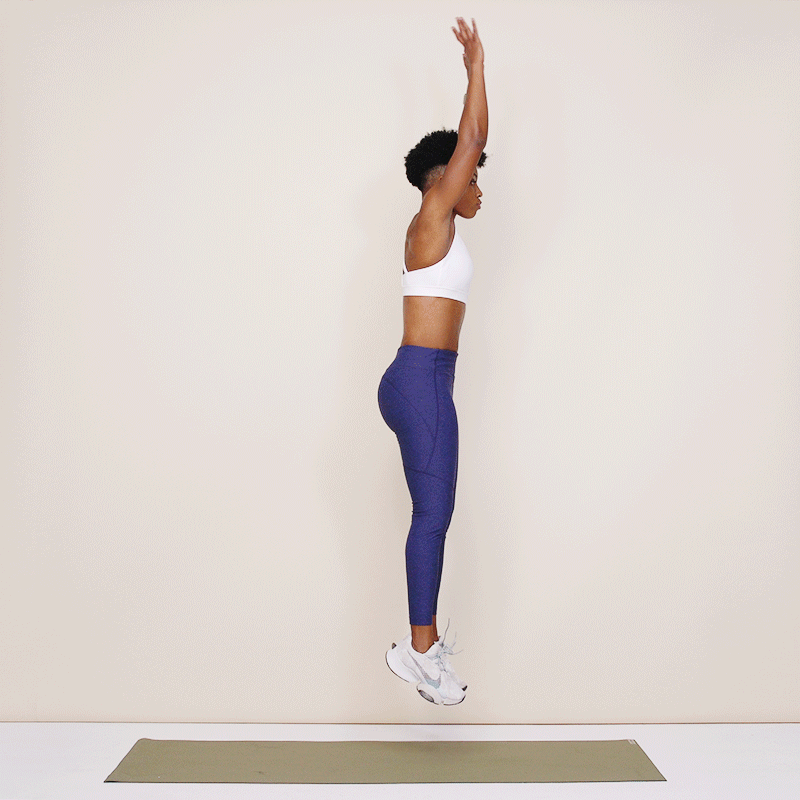
Katie Thompson
- Stand with your feet shoulder-width apart and arms by your sides.
- Squat and reach forward to place your hands on the floor, shoulder-width apart.
- Jump your legs straight out behind you into a high plank with your hands stacked underneath your shoulders.
- Lower your body to the floor, lift your palms up for a second, then place them back on the ground and push yourself back up to high plank.
- Jump your feet toward your hands, then spring up as high as you can, reaching your arms overhead.
- Land lightly on your feet for 1 rep. Immediately drop down into your next rep.
Burpees are a total-body plyometric move that work tons of muscles, including your shoulders, chest, core, glutes, and legs.
10. Box Jump
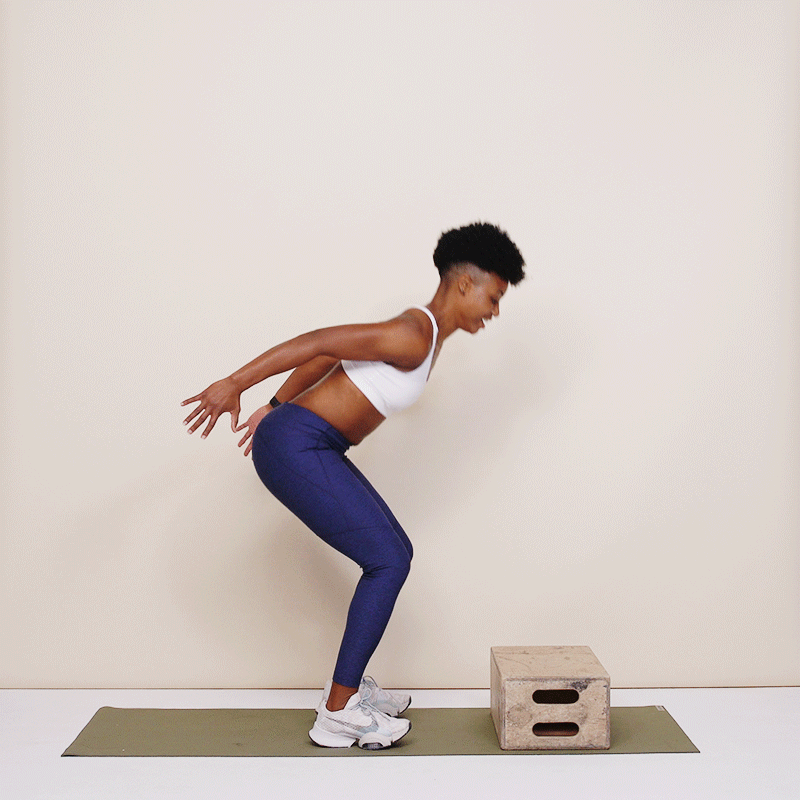
Katie Thompson
- Stand about a foot from a box or sturdy step on the balls of your feet with your feet hip-width apart.
- Bend your knees to lower into a squat and extend your arms straight behind you.
- Swing your arms forward and press through both feet to jump up on top of the box.
- Land with both feet fully on the box, hip-width apart, knees soft.
- Stand up, then step down to start another rep.
This is an advanced move, so make sure you’ve nailed proper form for the arm swing and landing stance before you attempt this on a box, says Hodges. When you land, make sure your knees don’t collapse inward, he adds.
11. Crab Walk to Jump
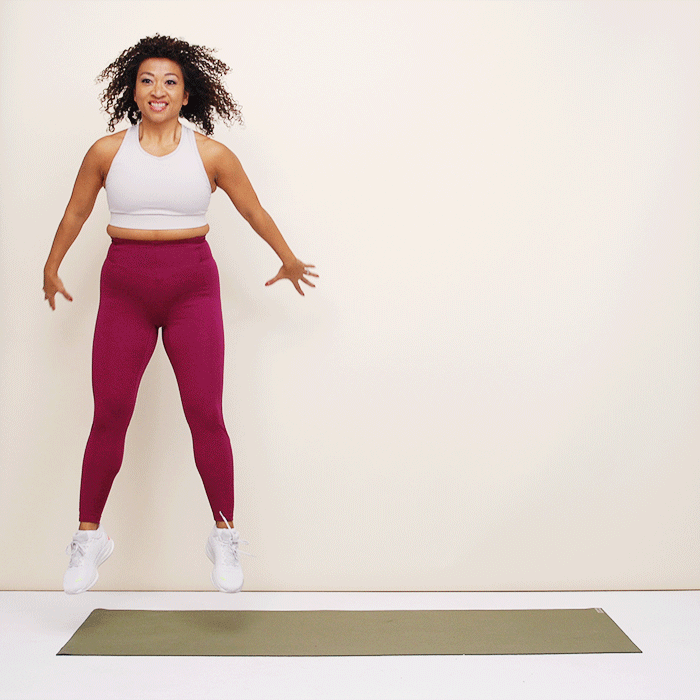
Katie Thompson
- Stand tall with your feet hip-width apart and core engaged.
- Send your hips back and bend the knees to drop into a quarter squat.
- Staying in the squat position, step to the right with your right foot and allow your left to follow. Take two more steps to the right with your right foot.
- Explode up, jumping and extending your legs fully, sending your arms behind you to help with momentum.
- Land lightly on the balls of your feet and immediately drop into a squat again. Repeat on the other side. This is 1 rep.
- Continue to alternate directions.
The lateral walk helps strengthen your hip abductors, and the jump adds power.
12. Single-Leg Deadlift to Jump
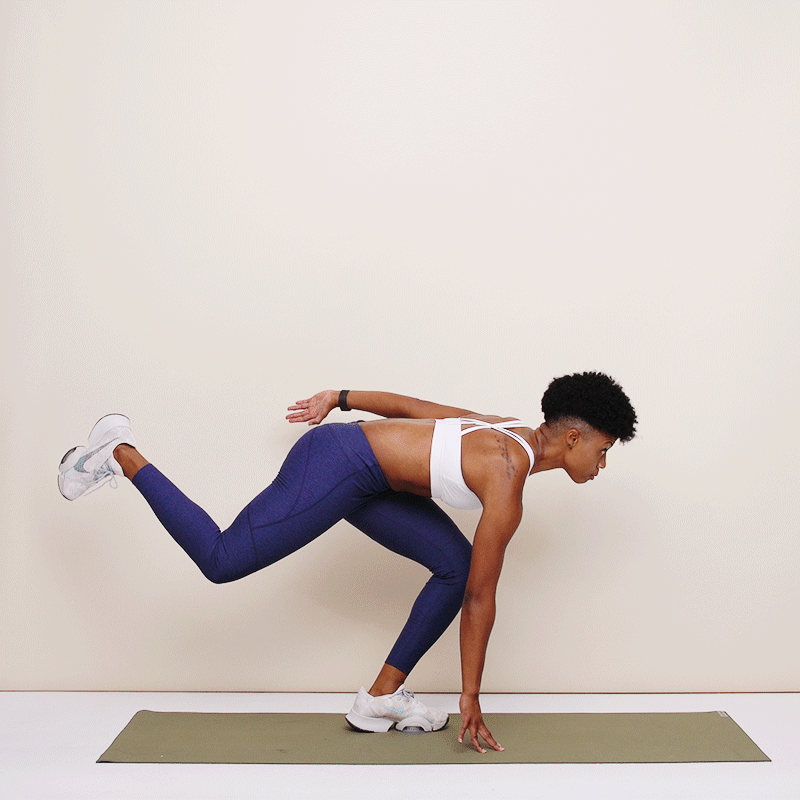
Katie Thompson
- Stand with your feet together. Shift your weight to your left leg and while keeping a slight bend in your left knee, hinge at your hips and tip your torso forward. Extend your right leg behind you, knee bent and toes pointing down toward the floor.
- Keep your back flat and core engaged and reach your right hand toward the floor. At the bottom of the movement, your torso should be almost parallel to the floor.
- Keeping your core tight, push through your left heel to jump as high as you can. Swing your right arm behind you, elbow slightly bent, and swing your left in front, elbow slightly bent.
- Land softly for 1 rep, then immediately lower down into a deadlift to start your next rep.
- Do all of the reps on the same side, then repeat on the other side.
This move is a plyometric version of the single-leg deadlift, a lower-body move that really works your backside muscles, including your hamstrings and glutes, as well as your core.
13. Lateral Lunge to Single-Leg Hop
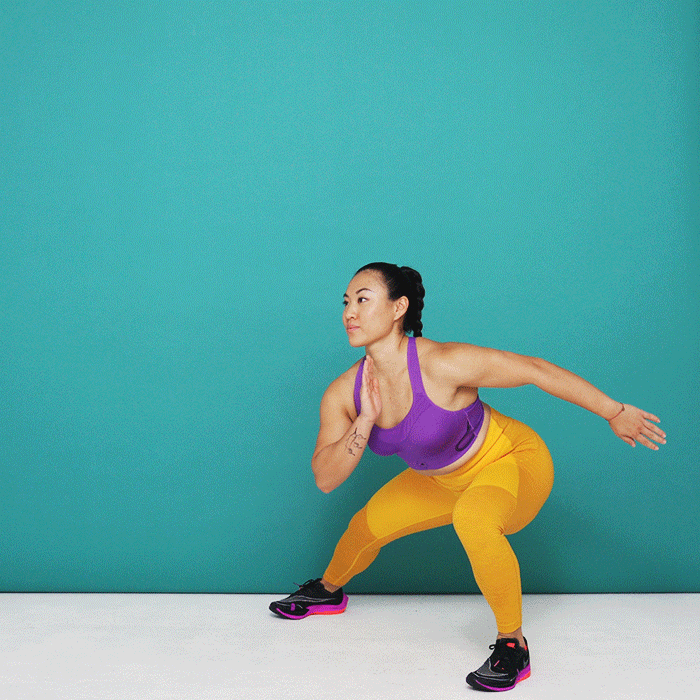
Katie Thompson
- Stand with your feet hip-width apart.
- Take a big step out to the left. Bend your left knee, hinge forward at the hips, and sit your butt back to lower into a lateral lunge. Keep your chest lifted and core engaged.
- Push through your left heel to return to standing, but instead of placing it back on the ground, immediately bring your knee toward your chest and hop up toward the ceiling.
- Land on your right foot with a soft knee and immediately move into the next rep.
The lateral movement here has you working in the frontal plane of motion, which better mimics everyday motion where we move in all kinds of directions—not just forward and backward. You’ll work your quads and glutes in this move too.
14. Hands-Release Push-Up
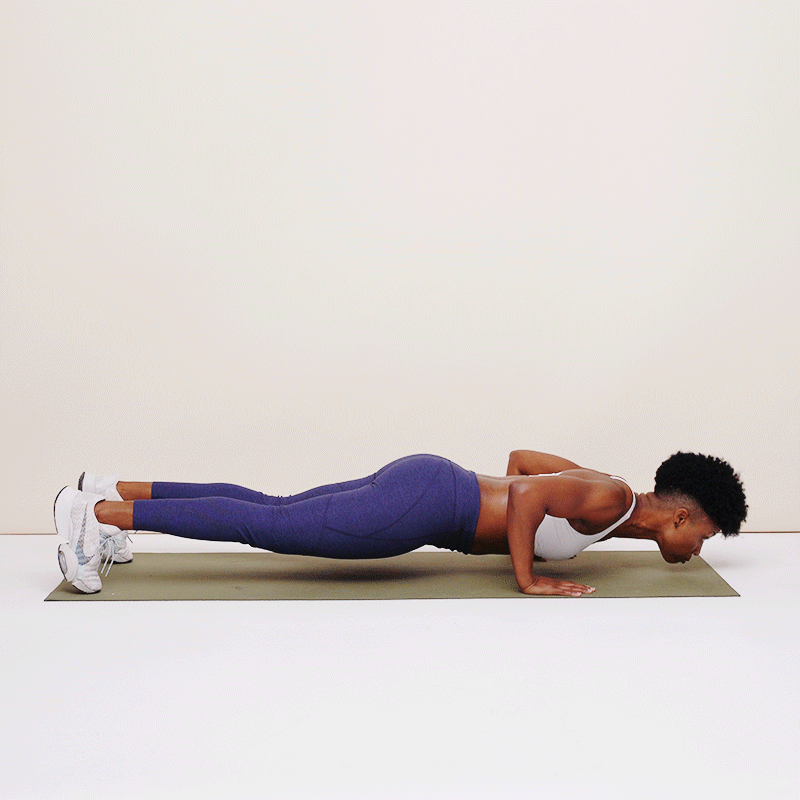
Katie Thompson
- Start in a high plank with your palms flat, hands shoulder-width apart, shoulders stacked directly above your wrists, legs extended behind you, and your core and glutes engaged.
- Bend your elbows and lower your chest to the floor.
- Push through the palms of your hands to straighten your arms and lift both palms off the ground several inches. Place palms back on the ground for 1 rep.
Though most plyo moves focus on the lower half, this exercise, a push-up variation, concentrates on your upper half. Push-ups really work your chest as well as your shoulders, triceps, and core.
15. Broad Jump to Burpee
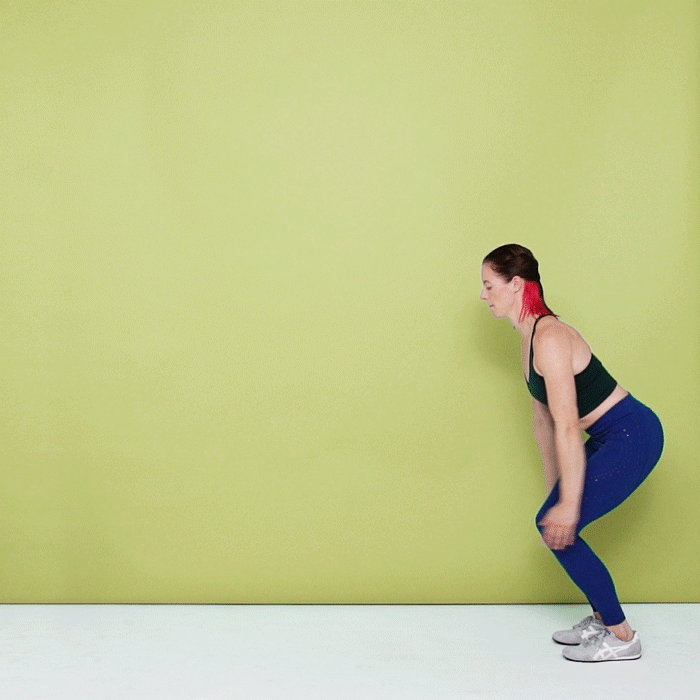
Katie Thompson
- Stand with your feet shoulder-width apart and arms by your sides.
- Bend your knees into a squat and jump forward about a foot, landing in a squat.
- Reach forward to place your hands on the floor, shoulder-width apart.
- Kick your legs straight out behind you into a high plank with your hands stacked underneath your shoulders.
- Bend your elbows to lower your chest to the floor.
- Push your body back up to a high plank and jump your feet toward your hands so your lower body is in a squat. Backpedal to the starting position.
The broad jump helps build explosive power and strengthens your lower body, including your glutes and calves.
16. In and Out Squat Jump

Katie Thompson
- Stand tall with feet together, palms pressed together at chest level. This is the starting position.
- Jump your feet wide as you bend your knees, hinge forward at your torso, and reach one arm towards the ground. Let your other arm swing behind you. Tap the ground with your fingertips and then jump your feet together and return to the starting position.
- Now repeat, this time reaching your other arm towards the ground. This is 1 rep.
This squat-centric move will fire up your lower half, especially your inner thighs (adductors), which engage when you jump your feet together.
Related:
- The Norwegian 4×4 Workout Could Help Boost Your Endurance
- What Is HIIT—and How Can It Boost Your Workouts?
- 7 Little Things Pilates Instructors Really Wish You’d Stop Doing in Class
Get more of SELF’s great service journalism delivered right to your inbox.


